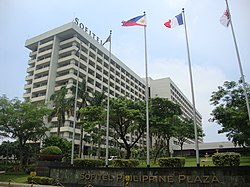The Sofitel Philippine Plaza Manila is a luxury hotel in Pasay, Metro Manila, Philippines under the Sofitel hotel chain of AccorHotels.
| Sofitel Philippine Plaza Manila | |
|---|---|
 Hotel logo | |
 | |
 | |
| Former names | Philippine Plaza, Westin Philippine Plaza |
| General information | |
| Status | Completed |
| Location | Cultural Center of the Philippines Complex, Bay City, Pasay, Philippines |
| Coordinates | 14°33′11.2″N 120°58′49.6″E / 14.553111°N 120.980444°E |
| Construction started | 1973 |
| Opening | September 26, 1976 |
| Renovated | 1994, 1995, 2007 |
| Closed | July 1, 2024 (expected) |
| Management | Westin Hotel Company (until 2005) AccorHotels (since 2006) |
| Technical details | |
| Floor count | 15 |
| Design and construction | |
| Architect(s) | Leandro Locsin Isidro Santos |
| Architecture firm | Leandro V. Locsin & Partners |
| Other information | |
| Number of rooms | 609 |
| Number of suites | 46 |
| Number of restaurants | 2 |
| Number of bars | 4 |
| Parking | 1 |
| Website | |
| www | |
History edit
Construction and opening edit
Originally named the Philippine Plaza, it was built during the martial law era administration of President Ferdinand Marcos.[1]
It was one of twelve luxury hotels[2] rushed to construction using funds drawn from Philippine Government finance institutions[3] at the behest of First Lady Imelda Marcos,[3] with the intention of presenting an impression of luxury[3] to the 2000 delegates who would attend the 1976 Annual Meetings of the International Monetary Fund and the World Bank, which would be held in Manila that year,[2] and is considered one of the examples of the Marcos couple's "edifice complex" fondness for the use of construction projects as political propaganda.[4][5]
It stands on land which was originally part of the Cultural Center of the Philippines Complex[6] and is owned by the Government Service Insurance System (GSIS).[7]
Design edit
The hotel itself was designed by Leandro Locsin of Leandro V. Locsin & Partners, who would later be named a National Artist of the Philippines for architecture, and Isidro Santos.[8][9]
Management and renovation history edit
The hotel was managed under the Westin brand until the management contract with Starwood hotels ended in 2005.[citation needed] The Westin Hotel Company made renovations on the hotel in 1994 and July 1995.[10] In 2006, the hotel signed a new management contract with AccorHotels.
The following year, after extensive renovation works worth millions of pesos, the hotel was rebranded as Sofitel Philippine Plaza.[11]
The management announced the hotel's closure, effective July 1, 2024,[12] following unresolved lease negotiations with the GSIS and ongoing considerations regarding refurbishment due to needed repairs.[7]
Features edit
In 1994, 12 years before the AccorHotels group took over ownership from Westin, the hotel hosted 670 guest rooms.[10] In 2016, it hosted 609 rooms and 46 suites.[13] It also features two restaurants, including the reputable Spiral Manila buffet restaurant, and four bars.[9]
The hotel hosts the Grand Plaza Ballroom which can accommodate between 1,000 and 1,400 people. For smaller functions, the ballroom can be divided into three smaller ballrooms that are given names of the country's three major island groupings: Luzon, Visayas, and Mindanao. The ballroom underwent a major renovation in 2014. Some of the ballroom's features designed by Locsin have been kept, most notably the Murano crystal chandeliers, which have been a fixture of all the rooms since the hotel's opening. The hotel management partnered with A. Ilustre and Associates for the renovation, while the architect firm in turn consulted architect Raul R. Locsin who works for the original firm behind the hotel.[8]
References edit
- ^ de Jesus, Sandra (June 25, 1987). "Philippine Plaza Hotel could be yours for ₱1B". Manila Standard. Retrieved August 11, 2016.
- ^ a b Alcazaren, Paulo (September 23, 2006). "Banking on hotels". Philstar.com.
- ^ a b c De Dios, E. S., Gochoco-Bautista, M. S., & Punongbayan, J. C. (2021). (DP 2021-07) Martial law and the Philippine economy. UPSE Discussion Papers.
- ^ Lico, Gerard (2003). Edifice Complex: Power, Myth, and Marcos State Architecture. University of Hawaii Press.
- ^ Ricardo., Manapat (1991). Some are smarter than others : the history of Marcos' crony capitalism. New York: Aletheia Publications. ISBN 9719128704. OCLC 28428684.
- ^ Afinidad-Bernardo, Deni Rose M. "31 years of amnesia: Edifice complex". Retrieved May 10, 2024.
- ^ a b Arnaldo, Ma. Stella F. (May 10, 2024). "Sofitel owner wants 25 years more on its lease with GSIS". BusinessMirror. Archived from the original on May 10, 2024. Retrieved May 10, 2024.
- ^ a b Vergara, Alex (November 19, 2014). "Hotel by the bay gets a $5-million facelift–without losing that Locsin touch". Philippine Daily Inquirer. Retrieved August 11, 2016.
- ^ a b "Sofitel Philippine Plaza Manila to cease ops in July 2024". Philstar.com. May 10, 2024. Retrieved May 10, 2024.
- ^ a b Gagelonia, Gynna (June 17, 1995). "A major makeover ups bay area hotel's ante in the tourism game". Manila Standard. Retrieved August 11, 2016.
- ^ "Deluxe hotel to get a new name". Philippine Daily Inquirer. February 5, 2006. Retrieved August 11, 2016.
- ^ Garcia, Nick (May 10, 2024). "Sofitel Philippine Plaza Manila to close its doors after five decades". The Philippine Star. Retrieved May 10, 2024.
- ^ "Sofitel Philippine Plaza Manila". Sofitel. Retrieved August 11, 2016.